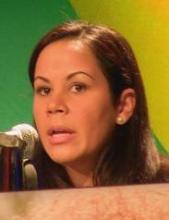MIAMI – Make sure patient and family expectations are realistic when you assess a child with a drooling disorder, Dr. Yamilet Tirado said.
"Success almost never means complete resolution of drooling," Dr. Tirado said at a pediatric update sponsored by Miami Children’s Hospital.
The use of fewer bibs, a decrease in soiled clothing, and improved socialization are examples of personal objectives that can dictate the success of conservative, medical, and/or surgical interventions to address sialorrhea, or excessive drooling. "In that context, about two-thirds of patients have some improvement," Dr. Tirado said.
Even without complete resolution of symptoms, intervention is important because sialorrhea is associated with significant quality of life impairment. "Patients and caregivers are equally affected by this problem," she said.
Patients can experience physical discomfort, skin infection, dehydration, and recurrent pneumonia that lead to stigmatization, social rejection, and isolation. Frequent patient hospitalizations, clothing changes, and laundry are among the caregiver burdens. Parents also experience anxiety, worry, and social isolation, added Dr. Tirado, a pediatric otolaryngologist at Miami Children’s Hospital.
Sialorrhea is a pathologic loss of saliva from the oral cavity. Interestingly, the majority of cases stem from an inability to swallow saliva, not from saliva overproduction, Dr. Tirado said. The etiology is often neurologic. Cerebral palsy, stroke, pseudobulbar palsy, juvenile Parkinson’s disease, and mental retardation can cause sialorrhea. Other culprits include peripheral neurologic disorders such as facial nerve palsy and glossopharyngeal nerve palsy. "Almost all affected patients have poor oral motor control and inefficient swallowing. They can also have poor head control, mouth breathing, and poor lip and tongue control," Dr. Tirado said.
A multidisciplinary approach can optimize outcomes. "Assessment and management of chronic drooling in children is best coordinated by a specialist medical team," Dr. Tirado said. The "drooling team" can consist of a pediatrician, an occupational therapist, a physical therapist, a dentist, an otolaryngologist, a pulmonologist, a neurologist, and a social worker.
The Drooling Rating Scale (Dysphagia 1988;3:73-8) is widely used to determine the frequency and severity of drooling, Dr. Tirado said. Parent questionnaires and visual analog rating scales are additional clinical assessment tools.
Consider both expectations and clinical presentation when devising your management strategy. "There are a considerable number of options for treatment depending on the age of the child and severity of the problem. The overall goal is to optimize quality of life without compromising oral or general health," she said.
Conservative approaches include wearing a bib, specific oral-motor exercises, and prescribed intraoral devices. Medical treatment usually precedes surgical intervention, but can be used as an adjunctive approach after surgery as well, Dr. Tirado said. She suggested that behavioral therapy be employed "whenever possible to reinforce techniques to improve swallowing."
Glycopyrrolate, scopolamine patches, benztropine, and ipratropium bromide are some of the medication options, "but there can be side effects," she said. Dry mouth, thick secretions, and urinary retention are examples.
Botulinum toxin type A "is now the preferred treatment when the medical treatment fails." The toxin is injected directly into the salivary gland under ultrasound guidance, usually under general anesthesia. The toxin blocks the release of acetylcholine, and the response lasts 3-6 months in the majority of patients, Dr. Tirado said. The maximum benefit occurs 4-6 weeks after injection.
About 60% of patients experience an excellent response; 20%, a good response; and the remaining 20%, a poor response – including 10% who do not respond even to high doses.
Botulinum toxin A therapy is safe and effective, Dr. Tirado said, and does not affect the adrenergic portion of salivary gland innervation. Adverse effects can include dysphagia, weak mastication, and gland infection.
Surgery is an option after medical therapy fails if a child is at least 4 years old, Dr. Tirado said. A patient with severe aspiration or profuse drooling with a low awareness level also might be a candidate for surgery. In contrast, surgery is contraindicated if the patient has neurologic disease that is not stabilized or has other health priorities.
Multiple surgical options include submandibular duct rerouting, four-duct ligation, bilateral submandibular gland excision, and tympanic neurotomy. In a meta-analysis of surgical management studies, bilateral submandibular duct excision with parotid duct rerouting was associated with the highest subjective rating of improvement – 88% (Arch. Otolaryngol. Head. Neck Surg. 2009;135:924-31). The researchers reported four-duct ligation had the lowest such rating – 64%.
Dr. Tirado said she had no relevant financial disclosures.


